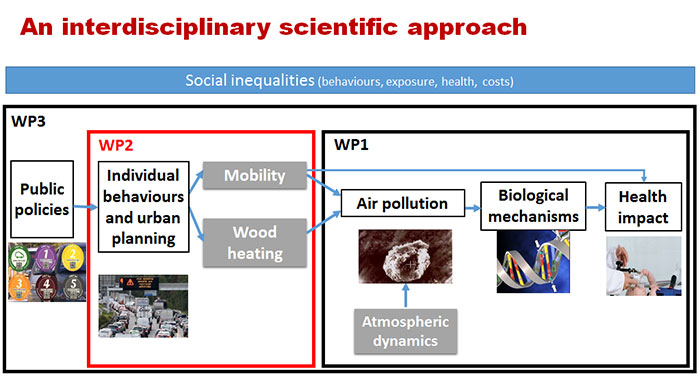- Share
- Share on Facebook
- Share on X
- Share on LinkedIn
An interdisciplinary scientific approach

WP2.A. Randomized controlled experiment targeting obstacles to shifts in transportation mode
Based on the identified scientific bottlenecks, we will develop and test the effectiveness of a program intervention aimed at changing durably transportation modes toward more active transport, by including both “hard” and “soft” levers, and based on a rigorous randomized controlled experiment. We will recruit a group of subjects using their car on a regular basis to go to work and open to shift to “cleaner” transportation modes.
Participants in the main arm of the study will follow an intervention program.
The intervention will include various facilitators. Other novelties of this study will be to examine the long-term effects of the intervention and to include objective measurements of behaviour change and environmental exposures. Specifically, the groups will be followed over a year (interviews, GPS monitoring trips, personal air pollution exposure, and quality of life). After the intervention, personal interviews will be conducted to understand why participants from each group did/did not change their mobility habits. Time-space activity, air pollution exposure, quality of life (through WHO SF36 questionnaire), and motivational variables (e.g., attitudes, perceived behavioural control) will be assessed before, during and after the intervention period in the intervention and control groups.
The intervention will imply:
- Selection of a homogeneous group of volunteers (in terms of life situation) issued from the population survey (above). A 2-week baseline observation will allow describing their usual daily space-time patterns (itineraries, transportation modes).
- the intervention phase
- and a post-intervention monitoring.
WP2.B. Mobility, heating and urban planning: what interactions and impacts on air quality on the long term?
Beyond changes of individual behaviours, levers of action on territories also rely on structural and collective levers related to an overall organization of the urban area planning. However, the modifications of land-use and transport infrastructures can only evolve and interact in the long run. Such long term issues are also central concerning the evolution of greenhouse gases emissions.
To explore the theoretical potential of these last levers, we will develop a modelling chain based on the sequence of three models: traffic simulation / emissions / concentration of pollutants in atmosphere. The traffic modelling is the TRANUS model of Grenoble area recently implemented by INRIA and IFSTTAR with the local authorities in the CITiES ANR project. TRANUS is a LUTI model (Transport and Land Use Interactions) and in addition to allow short-term traffic simulation, TRANUS can simulate the long term mutual interactions between the location of firms and households and transport offering. Pollutant emissions are estimated by ESPACE developed by ATMO AuRA which relies on National and European methodologies and comprehensive database of activities (vehicles number, ratio of heavy duty vehicles, speed …). Emission data thus generated are then used as inputs in the SIRANE model developed by ATMO AuRA to estimate the concentration of atmospheric pollutants (PM concentration, nitrogen oxides). This will allow assessing specific prospective evolution scenarios of the configuration of Grenoble area in the 2050 horizon.
Other emission drivers (technological evolutions of fleet of vehicles, energy efficiency of buildings, energy mix of the residential and service sectors, decrease of old diesel vehicles and low quality wood heating stoves) will also be investigated. Whenever possible, this work will rely on results developed in AETIC project (ANR Ville Durable 2009) and the BIOMQA project funded by ADEME.
- Share
- Share on Facebook
- Share on X
- Share on LinkedIn